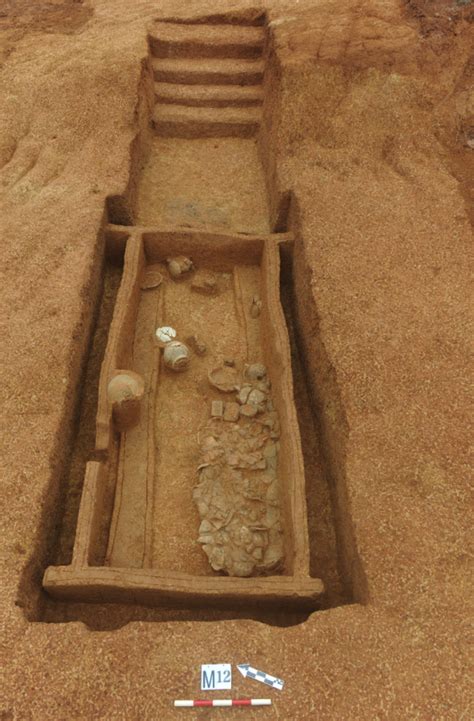
Three ancient tombs, believed to belong to a single family and filled with an array of artifacts, including bronze vessels, weapons, and jade objects, have been unearthed in central China’s Hubei Province, offering invaluable insights into the burial customs and social structure of the Zhou Dynasty (1046-256 BC).
Xiangyang, Hubei Province, China – Archaeologists have announced the discovery of three significant tombs dating back to the Zhou Dynasty in a cemetery in central China. The find, located in the city of Xiangyang, Hubei Province, is believed to be the final resting place of a single family, offering researchers a rare and comprehensive glimpse into the lives, rituals, and social hierarchies of the period. The tombs were meticulously excavated, revealing a wealth of artifacts that are expected to provide critical data about the political, economic, and cultural landscape of the time.
The excavation, conducted by the Xiangyang Institute of Cultural Relics and Archaeology, has yielded a rich collection of items, including bronze vessels, ceremonial implements, weapons, and jade ornaments. These objects are not only of significant historical value but also showcase the advanced craftsmanship and artistic sensibilities of the Zhou Dynasty artisans. The arrangement and nature of the artifacts within the tombs also shed light on the social status and familial relationships of the individuals buried there.
According to a statement released by the Institute, the discovery marks a crucial step forward in understanding the local history and culture of the Xiangyang region during the Zhou Dynasty. The Zhou Dynasty, which lasted for over eight centuries, was a formative period in Chinese history, witnessing significant developments in political philosophy, social organization, and cultural practices. The unearthed tombs provide a tangible link to this era, offering concrete evidence of the lifestyles and beliefs of the people who lived in the region.
“This is a very important discovery that will help us understand the social structure and burial customs of the Zhou Dynasty,” said Li Xinwei, the lead archaeologist overseeing the excavation. “The artifacts we have found are of high quality and provide valuable information about the lives of the people who were buried here.”
The artifacts recovered from the tombs are diverse and representative of different aspects of Zhou Dynasty life. The bronze vessels, often used in ritual ceremonies and banquets, are intricately decorated with patterns and inscriptions, providing insights into the religious beliefs and social customs of the time. The weapons, including swords, spears, and arrowheads, reflect the importance of military power and warfare in the Zhou Dynasty. The jade ornaments, symbols of wealth and status, are exquisitely crafted and highlight the artistic achievements of the period.
The arrangement of the tombs and the artifacts within them also provide clues about the social hierarchy and familial relationships of the individuals buried there. The central tomb, which is larger and more elaborate than the other two, is believed to belong to the head of the family. The other two tombs, located on either side of the central tomb, are likely the final resting places of the individual’s spouse or other close relatives. The artifacts found in each tomb also vary in quantity and quality, reflecting the different social statuses of the individuals buried there.
The discovery of the tombs has generated considerable excitement among archaeologists and historians, who believe that it has the potential to rewrite the history of the Zhou Dynasty in the Xiangyang region. The artifacts recovered from the tombs will be carefully studied and analyzed, and the findings will be published in academic journals and presented at conferences. The tombs themselves may also be opened to the public in the future, allowing visitors to experience firsthand the rich history and culture of the Zhou Dynasty.
The excavation is still ongoing, and archaeologists expect to uncover more artifacts and information in the coming months. The discovery of these three tombs is a testament to the rich history and cultural heritage of China, and it serves as a reminder of the importance of preserving and protecting archaeological sites for future generations. The research team is meticulously documenting every aspect of the excavation, ensuring that the findings are properly preserved and analyzed. They are also working closely with local authorities to ensure that the tombs are protected from looting and vandalism.
The unearthing of these tombs provides a unique opportunity to study the material culture of the Zhou Dynasty. Material culture encompasses all the physical objects that people create and use, including tools, clothing, housing, and art. By examining the artifacts recovered from the tombs, archaeologists can gain insights into the daily lives, social organization, and economic activities of the people who lived in the region during the Zhou Dynasty.
The discovery also sheds light on the burial customs of the Zhou Dynasty. Burial customs are the practices and rituals associated with death and burial. By studying the arrangement of the tombs and the artifacts within them, archaeologists can learn about the beliefs and values that shaped Zhou Dynasty burial practices. For example, the presence of jade ornaments in the tombs suggests that the individuals buried there were believed to have an afterlife, and that they would need these objects in the afterlife.
The Zhou Dynasty was a time of great change and innovation in China. During this period, the foundations of Chinese civilization were laid, including the development of Confucianism, Taoism, and other important philosophical and religious traditions. The discovery of these tombs provides a tangible link to this era, offering a glimpse into the lives of the people who shaped Chinese history. The excavation site is being treated with utmost care, adhering to international standards of archaeological practice. The team is using advanced techniques to document the location of each artifact and to preserve the integrity of the tombs.
The find promises to stimulate further research into the history and culture of the region and contribute to a deeper understanding of the Zhou Dynasty’s legacy. The local government has expressed its commitment to supporting the ongoing excavation and ensuring that the artifacts are properly preserved and displayed. The discovery also underscores the importance of archaeological research in preserving and understanding the past. By studying the material remains of past cultures, we can learn about the lives of our ancestors and gain a better understanding of our place in the world.
The archaeological team intends to expand the excavation area in the coming months, hoping to uncover additional tombs and artifacts. They also plan to conduct further research on the artifacts that have already been recovered, including analyzing their composition and dating them using scientific techniques. The ultimate goal is to create a comprehensive record of the site and to share their findings with the public.
The artifacts will be housed in a local museum, where they will be displayed for the public to view. The museum is also planning to create educational programs that will teach visitors about the Zhou Dynasty and the history of the region. The discovery of these tombs is not only important for archaeologists and historians, but also for the local community. It is a source of pride for the people of Xiangyang, and it helps to connect them to their past.
The tombs are located in a rural area on the outskirts of Xiangyang. The surrounding landscape is characterized by rolling hills and farmland. The site is easily accessible by road, and there are plans to build a visitor center and parking lot in the future. The discovery is also expected to boost tourism to the region. Visitors will be drawn to Xiangyang to see the tombs and artifacts, and to learn about the history of the Zhou Dynasty. This influx of tourism will provide a boost to the local economy and create new jobs.
The discovery is a reminder of the rich history and cultural heritage of China. The country is home to countless archaeological sites, and each one has the potential to reveal new information about the past. By preserving and protecting these sites, we can ensure that future generations will have the opportunity to learn about their history and heritage. The excavation team is also working with local universities and schools to involve students in the project. This will provide students with valuable hands-on experience in archaeology and help to inspire the next generation of archaeologists.
The discovery of the three Zhou Dynasty tombs in Xiangyang is a major archaeological find that will have a lasting impact on our understanding of Chinese history. The artifacts recovered from the tombs are of immense historical and cultural value, and they will provide invaluable insights into the lives of the people who lived in the region during the Zhou Dynasty. The excavation is still ongoing, and archaeologists expect to uncover more artifacts and information in the coming months. The findings will be shared with the public through publications, exhibitions, and educational programs.
Further analysis of the burial sites could potentially reveal insights into the health, diet, and genetic relationships of the individuals interred, offering a more personalized narrative of the Zhou Dynasty elite. Stable isotope analysis of skeletal remains could indicate dietary habits, while DNA analysis, if feasible, could confirm familial connections and shed light on migration patterns. This comprehensive approach to studying the tombs would contribute to a more nuanced understanding of the Zhou Dynasty’s social dynamics and cultural practices.
The Zhou Dynasty’s complex political structure, characterized by a decentralized feudal system, makes this discovery particularly relevant. The unearthed artifacts and burial arrangements may reflect the local power dynamics within the Xiangyang region and its relationship with the central Zhou court. Further investigation into the inscriptions and symbolic representations on the artifacts could offer clues about the political affiliations and social standing of the family buried in the tombs.
The economic context of the Zhou Dynasty also plays a crucial role in understanding the significance of the discovery. The presence of valuable materials such as bronze and jade suggests that the family had access to significant economic resources and played a prominent role in the local economy. Analyzing the distribution patterns of these materials within the tombs could reveal insights into trade networks and economic interactions during the Zhou Dynasty.
Moreover, the discovery has implications for the study of Zhou Dynasty art and craftsmanship. The intricate designs and sophisticated techniques used to create the bronze vessels and jade ornaments showcase the artistic achievements of the period. These artifacts can be compared to similar finds from other Zhou Dynasty sites to identify regional variations and stylistic influences. This comparative analysis would contribute to a broader understanding of the artistic landscape of the Zhou Dynasty and its cultural connections.
The significance of this discovery extends beyond the realm of archaeology and history. It also has implications for cultural heritage management and preservation. The local government’s commitment to supporting the excavation and preserving the artifacts demonstrates the importance of protecting archaeological sites for future generations. The discovery also raises awareness about the need for responsible tourism and sustainable development in areas with rich cultural heritage. By promoting cultural tourism, the local community can benefit economically while also preserving its cultural identity.
The meticulous documentation of the excavation process is crucial for ensuring the long-term preservation of the site. Archaeologists are using advanced technologies such as 3D scanning and photogrammetry to create detailed digital models of the tombs and artifacts. These models will be used for research purposes and for creating virtual reality experiences that will allow visitors to explore the tombs remotely. This innovative approach to cultural heritage management can help to make the site more accessible to the public and to promote a deeper appreciation of its historical significance.
The collaboration between archaeologists, historians, and local communities is essential for maximizing the benefits of this discovery. By working together, these stakeholders can ensure that the site is properly managed and that its cultural significance is fully understood and appreciated. The discovery of the three Zhou Dynasty tombs in Xiangyang is a testament to the power of archaeology to illuminate the past and to connect us to our shared human heritage.
The artifacts also provide a window into the religious and spiritual beliefs of the Zhou Dynasty. The symbols and motifs found on the bronze vessels and jade ornaments may represent deities, ancestors, or cosmological concepts. Further research into the iconography of these artifacts could shed light on the religious practices and spiritual worldview of the Zhou Dynasty elite.
The discovery also has implications for the study of ancient Chinese technology. The bronze vessels, weapons, and jade ornaments provide evidence of the advanced technological capabilities of the Zhou Dynasty. By studying the manufacturing techniques used to create these artifacts, archaeologists can learn about the technological innovations that drove economic and social development during the Zhou Dynasty.
In addition, the discovery highlights the importance of interdisciplinary research in archaeology. By combining archaeological data with insights from history, anthropology, art history, and other disciplines, researchers can gain a more comprehensive understanding of the Zhou Dynasty and its place in Chinese history. The Xiangyang excavation site is a valuable resource for scholars from around the world who are interested in studying ancient China.
The unearthing of these three tombs presents a valuable opportunity for public education and outreach. The local museum can create exhibits and programs that will educate visitors about the Zhou Dynasty and the significance of the discovery. These programs can target a wide range of audiences, including school children, tourists, and local residents. By engaging the public in the process of archaeological discovery, we can foster a deeper appreciation of the past and a greater sense of cultural identity.
The discovery also underscores the importance of protecting archaeological sites from looting and vandalism. Archaeological sites are vulnerable to damage and destruction from illegal digging and construction activities. By raising awareness about the importance of archaeological preservation, we can help to protect these sites for future generations. The local government’s commitment to supporting the excavation and protecting the site is a positive sign that the cultural heritage of the Xiangyang region is being taken seriously.
The Zhou Dynasty tombs in Xiangyang represent a significant contribution to our understanding of ancient Chinese history and culture. The artifacts recovered from the tombs are a valuable resource for researchers, educators, and the public. By studying and preserving these artifacts, we can learn about the lives of our ancestors and gain a better understanding of our place in the world.
The meticulous excavation and documentation of the tombs reflect the professionalism and dedication of the archaeological team. Their work is a testament to the importance of archaeological research in preserving and understanding the past. The discovery of the tombs is a reminder that the past is not just something that we read about in books, but it is also something that we can touch and experience through the material remains of past cultures.
The artifacts will undergo extensive conservation treatment to ensure their long-term preservation. The conservation process will involve cleaning, stabilizing, and repairing the artifacts. The conservators will use specialized techniques and materials to ensure that the artifacts are not damaged during the conservation process. The conserved artifacts will then be housed in a climate-controlled environment to prevent deterioration.
The discovery of the tombs also raises ethical questions about the treatment of human remains. The archaeologists are working closely with local authorities and community leaders to ensure that the human remains are treated with respect and dignity. The remains will be studied by physical anthropologists, who will attempt to learn about the health, diet, and lifestyles of the individuals who were buried in the tombs. The remains will then be reburied in a respectful manner.
The discovery of the three Zhou Dynasty tombs in Xiangyang is a remarkable achievement that will have a lasting impact on our understanding of ancient Chinese history and culture. The artifacts recovered from the tombs are a valuable resource for researchers, educators, and the public. By studying and preserving these artifacts, we can learn about the lives of our ancestors and gain a better understanding of our place in the world. The excavation is a testament to the importance of archaeological research and the dedication of the archaeologists who are working to uncover the secrets of the past.
The discovery of these tombs also underscores the importance of international collaboration in archaeological research. Archaeologists from around the world are working together to study and preserve the cultural heritage of China. This collaboration is essential for ensuring that the past is understood and appreciated by people of all cultures. The Zhou Dynasty tombs in Xiangyang are a reminder that the past is not just the history of one country or one culture, but it is the shared heritage of all humanity.
The ongoing research at the Xiangyang site will undoubtedly continue to yield new insights into the Zhou Dynasty and its place in Chinese history. The combination of careful excavation, advanced analytical techniques, and interdisciplinary collaboration promises to deepen our understanding of this formative period in Chinese civilization.
The discovery also presents opportunities for developing sustainable tourism initiatives that promote cultural heritage and benefit local communities. By engaging local residents in the preservation and interpretation of the site, it is possible to create a sense of ownership and pride in their cultural heritage. This, in turn, can lead to economic opportunities and improved livelihoods.
The three tombs provide a microcosm of Zhou Dynasty society, reflecting the social hierarchies, economic activities, and cultural beliefs of the time. By studying the arrangement of the tombs, the artifacts they contain, and the human remains interred within them, archaeologists can reconstruct a vivid picture of life in ancient China. This picture can then be compared with findings from other Zhou Dynasty sites to create a broader understanding of this complex and influential period in Chinese history. The site will likely become a key location for archaeological training and education, helping to foster the next generation of experts in the field.
Frequently Asked Questions (FAQ)
1. Where were these ancient tombs discovered, and what is their significance?
The tombs were discovered in the city of Xiangyang, Hubei Province, in central China. They are significant because they are believed to belong to a single family from the Zhou Dynasty (1046-256 BC) and contain a rich collection of artifacts that provide valuable insights into the burial customs, social structure, and material culture of the period. According to Li Xinwei, the lead archaeologist, “This is a very important discovery that will help us understand the social structure and burial customs of the Zhou Dynasty.”
2. What types of artifacts were found inside the tombs?
The tombs contained a diverse array of artifacts, including:
- Bronze vessels (used in ritual ceremonies and banquets)
- Ceremonial implements
- Weapons (swords, spears, arrowheads)
- Jade ornaments (symbols of wealth and status) These artifacts provide insights into the religious beliefs, social customs, military power, and artistic achievements of the Zhou Dynasty.
3. How does the arrangement of the tombs reflect the social hierarchy of the family buried there?
The central tomb, larger and more elaborate than the other two, is believed to belong to the head of the family. The other two tombs, located on either side, likely belong to the individual’s spouse or other close relatives. The artifacts found in each tomb also vary in quantity and quality, reflecting the different social statuses of the individuals buried there.
4. What are the plans for preserving and studying the artifacts found in the tombs?
The artifacts will be carefully studied and analyzed by archaeologists and historians. The findings will be published in academic journals and presented at conferences. The artifacts will be housed in a local museum and displayed for the public. The museum is also planning educational programs to teach visitors about the Zhou Dynasty and the history of the region. The excavation team is using advanced techniques to document the location of each artifact and to preserve the integrity of the tombs.
5. What impact is the discovery expected to have on tourism and the local economy?
The discovery is expected to boost tourism to the Xiangyang region as visitors will be drawn to see the tombs and artifacts and learn about the Zhou Dynasty. This influx of tourism will provide a boost to the local economy and create new jobs. The local government has expressed its commitment to supporting the ongoing excavation and ensuring that the artifacts are properly preserved and displayed, which is expected to enhance tourism in the long run.









